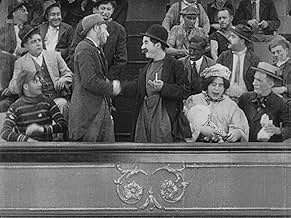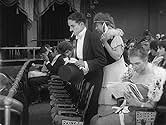Mr. Pest tries several theatre seats before winding up in front in a fight with the conductor. He is thrown out. In the lobby he pushes a fat lady into a fountain and returns to sit down by ... Read allMr. Pest tries several theatre seats before winding up in front in a fight with the conductor. He is thrown out. In the lobby he pushes a fat lady into a fountain and returns to sit down by Edna. Mr. Rowdy, in the gallery, pours beer down on Mr. Pest and Edna. He attacks patrons,... Read allMr. Pest tries several theatre seats before winding up in front in a fight with the conductor. He is thrown out. In the lobby he pushes a fat lady into a fountain and returns to sit down by Edna. Mr. Rowdy, in the gallery, pours beer down on Mr. Pest and Edna. He attacks patrons, a harem dancer, the singers Dot and Dash, and a fire-eater.
- Lady in Audience
- (uncredited)
- Man in Balcony
- (uncredited)
- Ticket Taker
- (uncredited)
- …
- Man Behind Bead Lady
- (uncredited)
- First in Line
- (uncredited)
- …
- Gentleman in Audience
- (uncredited)
- Tuba Player
- (uncredited)
- Member of 'Dot and Dash'
- (uncredited)
- …
- Trombone Player and Singer
- (uncredited)
- …
- Large Boy
- (uncredited)
- Feather Duster
- (uncredited)
- …
- Lady in the Stalls
- (uncredited)
- Lady in the Stalls with Beads
- (uncredited)
- Orchestra Conductor
- (uncredited)
- Tootsy Frutti the snake charmer
- (uncredited)
- Second Man in Balcony Front Row
- (uncredited)
- Director
- Writer
- All cast & crew
- Production, box office & more at IMDbPro
Featured reviews
This is one of the few of these early films that could withstand repeated watching of it.
Appropriately enough, this is also a rare outing for Chaplin's aristocratic drunk act, which predates his little tramp, having originated in his days with the Karno troupe. While not as versatile or sympathetic as the tramp, the drunk could nevertheless be just as funny. With Chaplin's refined directorial style, he makes the most of the character's antics, allowing him to bumble about in a series of long takes. He is joined by "Mr Rowdy", also played by Chaplin, a character I have not seen anywhere else, but who bares a slight resemblance to the screen persona of Ben Turpin, who made a few appearances for Chaplin in earlier Essanay shorts. Mr Rowdy isn't exactly hilarious, although he allows for some interplay between the two Chaplins, as we see the drink Rowdy pours from the gallery landing on the drunk in the stalls in two separate shots, which is a kind of cinematic joke in itself – and one thing Chaplin couldn't have done on stage.
In fact, this whole piece seems to be Chaplin showing off the advantages of screen over stage. Although in the Karno sketch the drunk would be planted in the audience, right by the stage as we see him here, it did not involve the audience any further. In the medium of film, Chaplin can make as many gags as he wants among the on screen audience. In the most bizarre bit of nose-thumbing, there is even a Georges Melies moment, when the demonic fire-eater "appears" on stage with a stop-trick. It is, in many ways, one of the most intelligent shorts Chaplin made at Essanay. And yet, sadly it isn't very funny. It doesn't have the sense of cohesion or build up of gags that we would expect from a Chaplin short by this point.
But there's still time for the all-important statistic - Number of kicks up the arse: 1 (1 for)
Of course, it's not always his fault, as in this case, he is led to the wrong seat, causing him to make his way down these crowded aisles repeatedly, upsetting more people every time. The film begins to delve into simplistic but hilarious violence as Charlie ultimately proceeds to belligerently punch everyone in sight with his characteristic roundhouse punches, bringing the whole house to their feet and having to be forcefully removed. He is seated in another section while the conductor of the band in the show (the first person he attacked) puts himself and his equipment back together in an effort to begin the rest of the show.
There is an element of foreshadowing in the film as we witness another person who is not unruly, but who is a little unstable on his feet and who resembles the Tramp far too much to be anything but a person who is going to cause some trouble at some point in the film, with the expected result that everyone will take him as the Tramp and Charlie will take the blame for whatever he does. This guy turns out to be a mildly amusing character as he cheerfully dumps a beer from the balcony onto the audience below, where the Tramp, fresh from shoving a fat lady into a tub of water, is flirting with a flapper girl who he caught eyeing him from across the room.
Not exactly the best stuff from Chaplin, but one of the funniest scenes in the film is the one in which the Tramp goes to hold the girl's hand and winds up holding the hand of her beefy date, fluttering his eyelids at her all the while, completely oblivious. He moves again when he discovers his plunder, only to begin getting himself in trouble yet again. He ultimately manages to get himself into a fight right on the stage where the show is taking place, only to be moved yet again.
Charlie seems to be more vexed than usual with people in general in this film, which is understandable near the end when he gets seated next to a horribly aggravating fat kid, as the movie is reduced to a food fight, and the show gets the biggest applause after Charlie has gone on stage to put a pie in the face of the guy singing. It's pretty clear that Charlie is making a comment with this film about the quality of the average stage production in 1915, because all of the acts in the film are pretty bad. No wonder the Tramp's upset for so much of the film.
As is pretty traditional with these early Chaplin short films, A Night in the Show does not end with much of a conclusion, but rather with another comedy skit, the grand finale, if you will. This is by far the funniest scene in the film, in which the Tramp look-alike in the balcony takes a fire hose and proceeds to hose down everyone in the auditorium. What a great scene! There are some truly great laughs in that scene, although I remain unsure about why there was a fire hose in the middle of an auditorium. I'm sure I just don't know enough about the fire standards of 1915, but regardless of why it's there, it makes a great prop for the film.
A Night in the Show is definitely not one of the best or most memorable of Chaplin's early films, but the quality is there and it is, as they all are, a cinematic curiosity piece in that it was made by one of the greatest filmmakers in the history of the medium.
Storyline
Did you know
- TriviaBased on a famous comedy act called "Mummingbirds" in which Charles Chaplin starred when he was a player with The Karno Company in England.
- GoofsWhen the snake charmer is near Mr Rowdy, you can see she is barefoot. But, a shot after, she is wearing low heeled boots.
- ConnectionsEdited into Chaplin's Art of Comedy (1966)
Details
- Release date
- Country of origin
- Official site
- Languages
- Also known as
- Вечір у шоу
- Production company
- See more company credits at IMDbPro
- Runtime24 minutes
- Color
- Sound mix
- Aspect ratio
- 1.33 : 1
Contribute to this page

































